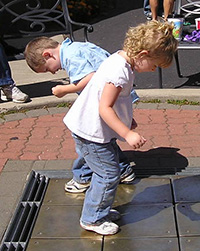About Autism
 Autism is a brain disorder that affects people of all races, nationalities, and socioeconomic backgrounds. Its onset is typically between one and three years of age. According to the Centers for Disease Control and Prevention (CDC) about 1 in every 110 children has an Autism Spectrum Disorder. Autism is the fastest growing developmental disability in the United States, with a growth rate of over 10 percent every year.
Autism is a brain disorder that affects people of all races, nationalities, and socioeconomic backgrounds. Its onset is typically between one and three years of age. According to the Centers for Disease Control and Prevention (CDC) about 1 in every 110 children has an Autism Spectrum Disorder. Autism is the fastest growing developmental disability in the United States, with a growth rate of over 10 percent every year.
Studies show that while autism has a strong genetic component, the environment plays an important role in triggering the disorder. According to research, brain regions and neurons in people with Autism Spectrum Disorders (ASDs) are different from those without the condition. These neurological differences create poor connections between brain areas, which lead to difficulties with sensory processing, language, social understanding, and behavior.
 The early diagnosis of autism is critical for receiving effective intervention. Children with ASD who receive intervention while the brain is most adaptable show the greatest improvement. However, even if a diagnosis is made in adolescence or adulthood, interventions are still helpful due to the brain’s continued plasticity. Find a list of autism interventions HERE.
The early diagnosis of autism is critical for receiving effective intervention. Children with ASD who receive intervention while the brain is most adaptable show the greatest improvement. However, even if a diagnosis is made in adolescence or adulthood, interventions are still helpful due to the brain’s continued plasticity. Find a list of autism interventions HERE.
Clinicians use many criteria to diagnose ASD, including behavioral characteristics, extreme sensitivities, and repetitive behaviors. Among the tools used are checklists, clinical observation, interviews, and questionnaires for parents or teachers. You can learn more about the signs and symptoms of autism HERE.
You can learn more facts about ASDs in the NIMH’s Autism Web Site. You can also read or download a longer NIMH article about autism.
The following list of “red flags” from the Mayo Clinic indicates that an individual may have an ASD. If you are a parent and notice that your child exhibits these behaviors, or if you are an adult and observe these behaviors in yourself, please contact us. We will refer you to a specialist who diagnoses ASDs.
Social skills
- Fails to respond to his or her name
- Has poor eye contact
- Appears not to hear you at times
- Resists cuddling and holding
- Appears unaware of others’ feelings
- Seems to prefer playing alone — retreats into his or her “own world”
Language
- Starts talking later than age 2, and has other developmental delays by 30 months
- Loses previously acquired ability to say words or sentences
- Doesn’t make eye contact when making requests
- Speaks with an abnormal tone or rhythm — may use a singsong voice or robot-like speech
- Can’t start a conversation or keep one going
- May repeat words or phrases verbatim, but doesn’t understand how to use them
Behavior
- Performs repetitive movements, such as rocking, spinning or hand-flapping
- Develops specific routines or rituals
- Becomes disturbed at the slightest change in routines or rituals
- Moves constantly
- May be fascinated by parts of an object, such as the spinning wheels of a toy car
- May be unusually sensitive to light, sound and touch and yet oblivious to pain
Providing Autism Support in Pennsylvania
412-781-4116 800-827-9385 support@AutismOfPA.org